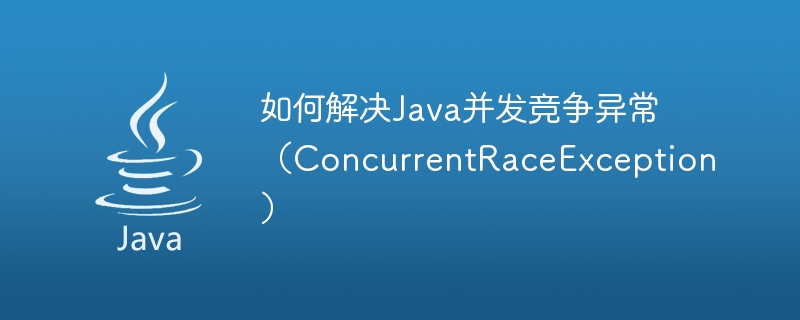Home >Java >javaTutorial >How to solve Java concurrency race exception (ConcurrentRaceException)
How to solve Java concurrency race exception (ConcurrentRaceException)
- 王林Original
- 2023-08-17 10:03:12911browse

How to solve Java concurrency competition exception (ConcurrentRaceException)
Introduction:
With the popularity of multi-core processors and the increase in application complexity, multi-threaded programming It has become an integral part of modern software development. However, multi-threaded programming also introduces a series of challenges, one of which is Concurrent RaceException. This article explains what a concurrency race exception is and how to resolve it.
1. What is a concurrency competition exception?
In multi-threaded programming, multiple threads access and modify shared resources at the same time, which may lead to inconsistent data or unpredictable behavior. Concurrency contention occurs when multiple threads modify the same shared resource. Without appropriate synchronization mechanisms, concurrent access to shared resources by multiple threads can lead to data race issues, which can lead to exceptions. Concurrency race exception in Java is called ConcurrentRaceException.
2. Methods to solve concurrency competition exceptions
In order to solve concurrency competition exceptions, we can take the following methods:
- Use thread-safe data structures
Java provides some thread-safe data structures, such as ConcurrentHashMap, CopyOnWriteArrayList, etc. Using these data structures can ensure that concurrent access to resources by multiple threads will not cause race exceptions.
The following is a sample code using ConcurrentHashMap:
import java.util.Map;
import java.util.concurrent.ConcurrentHashMap;
public class Example {
private Map<String, Integer> map = new ConcurrentHashMap<>();
public void increment(String key) {
// 原子性操作,保证线程安全性
map.putIfAbsent(key, 0);
map.computeIfPresent(key, (k, v) -> v + 1);
}
public int getValue(String key) {
return map.getOrDefault(key, 0);
}
}- Using the lock mechanism
Using the lock mechanism can ensure that only one thread accesses shared resources at a time. This avoids concurrency contention issues.
The following is a sample code using the lock mechanism:
import java.util.concurrent.locks.Lock;
import java.util.concurrent.locks.ReentrantLock;
public class Example {
private int count = 0;
private Lock lock = new ReentrantLock();
public void increment() {
lock.lock();
try {
count++;
} finally {
lock.unlock();
}
}
public int getValue() {
lock.lock();
try {
return count;
} finally {
lock.unlock();
}
}
}- Using atomic operations
Java provides some atomic operation classes, such as AtomicInteger, AtomicLong wait. These classes provide thread-safe atomic operations to ensure that concurrent access to resources by multiple threads will not cause competition exceptions.
The following is a sample code using AtomicInteger:
import java.util.concurrent.atomic.AtomicInteger;
public class Example {
private AtomicInteger count = new AtomicInteger();
public void increment() {
count.incrementAndGet();
}
public int getValue() {
return count.get();
}
}Summary:
In multi-threaded programming, resolving concurrency competition exceptions is an important task. This article introduces the concept of concurrency race exceptions and provides some solutions: using thread-safe data structures, using locking mechanisms, and using atomic operations. Proper application of these methods can ensure the correctness and performance of multi-threaded programs.
While there are many ways to resolve concurrency race exceptions, there is no one-size-fits-all solution that works in all situations. In practical applications, we need to choose appropriate solutions based on specific business scenarios and conduct appropriate performance testing and tuning.
The above is the detailed content of How to solve Java concurrency race exception (ConcurrentRaceException). For more information, please follow other related articles on the PHP Chinese website!

